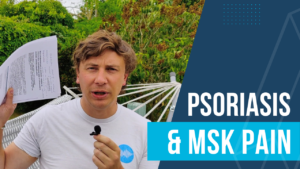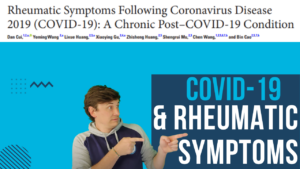Its an interesting concept really in Musculoskeletal Practice, assessing multiple systems. We do this in many conditions e.g. thyroid, hormonal changes, diabetes… Rheumatology is no different but often its different symptoms to the ones we are used to in MSK. The skin, the gut and also the nails.
How many of us assess nails in clinic? We should, its highly important for a number of reasons clubbing is a good example. In this case it also turns out to be very useful in Psoriatic Arthritis. A recent article came to my attention and I will use this blog to highlight some of the applications for us in MSK.
Psoriatic Arthritis features in my Rheumatology At A Glance Booklet and Clinical Scenarios eBook, you can find them both in my shop. Do consider these resources both for your own learning and to support me to continue to create these blogs and resources!
As usual feedback is greatly appreciated and any further reading for me please send it my way!
PLEASE REMEMBER – THIS BLOG IS NOT A REPLACEMENT FOR CLINICAL REASONING, IF YOU ARE UNSURE GET ADVICE
Introduction
Psoriatic Arthritis is an Enthesitic condition under the umbrella of Spondyloarthritis, this means the autoimmune response is directed at the Entheses. It’s a complex condition with highly variable presentations mostly peripheral but some are predominantly axial.
Most have Psoriasis or a history of it but a small percentage don’t. Approx 1 in 4 psoriasis patients will develop a related arthritis. Many will attend clinic with formally diagnosed Psoriasis but some won’t and unless directly asked many won’t immediately consider a link to their symptoms when you are asking past medical history so I advocate asking directly in all attendees.
Nails
Psoriasis can affect the nails as well as the skin, in particular it can cause an appearance known as onchyolysis which is a painless detachment of the nail from the nail bed. It can occur on any of the nails.
This particular study looked at the association of the presence of onchyolysis with tendon thickness and Distal Interphalangeal Joint erosions. They found that in patients with Onchyolysis vs those with only cutaneous Psoriasis the Onchyolysis patients had a higher likelihood of both thicker tendons (enthesopathy) and bone erosions.
What does that mean?
These patients did not have diagnosed Psoriatic Arthritis, so these findings could be defined as sub-clinical. i.e. existing pathology without reported symptoms. This is highly important because in other conditions such as RA its been shown that sub-clinical disease remains important and needs to be managed or progression can still occur despite having no symptoms.
Perhaps more importantly it provides an opportunity to appropriately refer to Rheumatology for investigations and get an early diagnosis. We know that across the board in inflammatory Rheumatological conditions earlier diagnosis is associated with vastly improved outcomes in almost every measurable variable.
Apply to MSK Practice
This study (in my opinion) adds weight to the rhetoric that I encourage. We must be aware of these symptoms that are involved in systemic conditions or we will easily miss opportunities to improve outcomes.
Do I advocate looking at every patients nails? No. Use your clinical judgement, someone visiting with a sprained ankle probably doesn’t need their nails checked. BUT. If they have or had psoriasis then definitely check them, if they have multiple joint pain, tendinopathy, insidious onset low back or buttock pain then check them.
Spondyloarthritis diagnoses are unacceptably delayed and this is one potential avenue to improve that. We need to be assessing the nails in appropriate patients and making sure we know what we are looking for.
End
I hope this has been useful, makes you consider your assessments in more depth and consider the body systems. Lets be the best clinicians we can be for each patient by knowing as much as we can!
Get me any feedback you might have so that I can grow and improve.
We go into a lot of depth on Psoriatic Arthritis on my Online and In-Person courses
See you next time!
References
Axel P Villani, Stéphanie Boutroy, Céline Coutisson, Marie-Christine Carlier, Loïs Barets, Hubert Marotte, Bertrand Richert, Roland D Chapurlat, Denis Jullien, Cyrille B Confavreux, Distal phalangeal bone erosions observed by HR-pQCT in patients with psoriatic onycholysis, Rheumatology, , keaa415, https://doi.org/10.1093/rheumatology/keaa415
Other blogs you might be interested in Gold Standard Time To Diagnosis & AxSpA an Overview Document & Screendem


